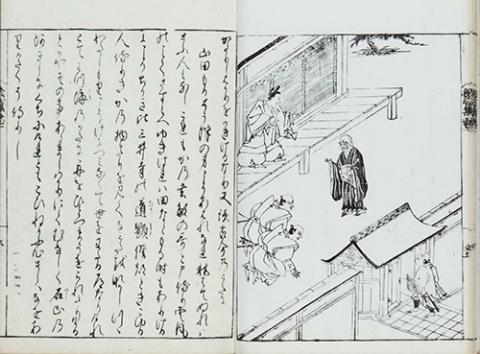◆About this Collection
Databases of old books held by Nagoya University, describing bibliography, additionally contents and comments.
Among the activities of human beings as "homo memor mori (people who know death)," the most exquisite activity is to leave behind books (literary materials). Through books, people overcame death as individuals and made communication between different generations possible. Therefore, I would like to call not only the authors of books but also the transcribers, publishers, custodians, collectors, decipherers, etc., all those who are involved in intergenerational communication through books "homo librarius" (people of books), as people among people. We are homo librarius.
To be homo librarius, we must listen to the voices of the dead, often by going into the library and making the most of the classical books. This system is an attempt to do so.
◆Motive
Conventional Japanese catalogs of antiquarian books are simplistic in their descriptions, making it difficult to fully understand what is written in the book and what bibliographic characteristics it possesses. This system aims to provide in-depth descriptions so that the contents and bibliography can be properly understood. We hope that this system will enable us to understand the contents of the materials and make effective use of the bibliography in the future, even if there is no living person to guide the bunko.
In addition, there is a possibility that organic connections between materials can be found by making full use of searches for names, seals, and other information recorded in the materials. This should be a pleasure never before known to the ancients.
I hope that all Japanese libraries will be equipped with such a system. In this way, we will be able to uncover many things that could not be discovered from individual documents alone, and the dead who have left us their books will suddenly have much to tell us.
◆About Nagoya University’s Library Jingu Kogakkan Collection
The Jingu Kogakkan Collection is the former collection of Jingu Kogakkan University, which was a government-run university before the war. When the university was closed down by order of the occupying forces in March 1946, it was taken over by Nagoya University, a nearby government-run university. Among these collections, some of the materials related to Ise Jingu and Goshi were transferred from Nagoya University to the Jingu Bunko in July 1947, but the rest were delivered to the Nagoya University Library in March 1948 and renamed the Jingu Kogakkan Collection.
Many of the classical works in the collection are from the collection of the Kita Shinzaemon family, who were masters (goji) of the Ise Jingu Shrine, and include many highly valuable materials, mainly poetry books, renga books, and books on the history of court nobles. However, until now, there has only been a brief catalog of the collection in book form, and it also contains materials that were omitted from that catalog, that is, materials not included in the Kokusho Sou Mokuroku (国書総目録). As noted above, the books in the bibliography were collected and brought to Japan without the intention of being originally located in Nagoya, and we believe that it is imperative to first create as detailed a bibliography as possible in order to make the books more widely and appropriately available to the world. We are pleased to present here a new method of "descriptive" bibliographic cataloging of classical books.
◆References
(Japanese old books)
1. Shiomura, Koh, Studies in Early Modern Literature: Biography, Bibliography, and Publication (Wakakusa Shobo, 2004), chapter 1, 2 OPAC
2. Shiomura, Koh (ed.), Iwase Bunko Shoshi Mokuroku no tame no Shikō Senten Mokuroku (Trial Catalogue of 1,000 Items for the Bibliography of the Iwase Collection) (kyukoshoin, 2001) OPAC
3. "Kosho wa Kataru" (Old Books Speak) Catalog (Nagoya University Library, 2002), first half and second half OPAC
4. "There was such a book! -Iwase Bunko Heisei Shikkai Chosa Shokai I & II," catalog (Iwase Bunko, 2004 & 2005).
◆About the Use of the Database
The copyright of this database belongs to the Nagoya University Library. However, the electronic materials posted here are freely available for public use.
Please review the following notes before using the materials:
・The images published in this collection are released under the public domain and may be used freely without restriction.
・When using the materials, please include a credit statement that specifies the “Title of the Material” and the “Holding Institution (Nagoya University Library)."
・If you use any of the materials, we would greatly appreciate it if you could report your usage via the “Content Usage Report Form” to help improve future operations.
・If you publish image data in academic books or similar publications, we would be grateful if you could provide us with a copy of your work (this is not a mandatory requirement).
Provided materials may be made available for viewing and reference at our library.
The thumbnail image is from page 8 of 鴨長明 ,"発心集" owned by Nagoya University Library, retrieved from Kotenseki Descriptive Database(https://da.adm.thers.ac.jp/en/item/n004-20230901-02310)
